The AMD Radeon VII Review: An Unexpected Shot At The High-End
by Nate Oh on February 7, 2019 9:00 AM ESTProfessional Visualization and Rendering
With AMD strongly pushing the Radeon VII as a prosumer content creation card, it behooves us to look at rendering, CAD, and professional visualization performance. However, accurate and applicable benchmarks for this field are not so easy to find, especially since performance is highly dependent on workflow and proprietary licensed ISV software. Given AnandTech’s audience, which often includes engineers using these applications in critical production environments, our goal is to provide the most relevant metrics. However, as Ian has discussed previously, the route to the most accurate workstation benchmarking for professional applications is in the hands of ISVs, who are at best blasé and more typically negative about providing access, even at the prospect of lending limited software licenses in return for ongoing discussion and third-party benchmark data of their software.
Those caveats in mind, the next best thing for evaluating overall GPU workstation performance is the venerable SPECviewperf, recently updated to version 13. Separated into ‘viewsets,’ which are a group of application-specific workloads derived from real-world datasets, SPECviewperf has been a longstanding suite for generalized workstation/CAD GPU performance. For SPECviewperf 13, the viewsets are based on:
- Autodesk 3ds Max 2016 (Nitrous DX11 driver)
- Dassault Systèmes CATIA V6 R2012
- PTC Creo 3 & Creo 4
- Geosurvey software, with workloads based on rendering techniques utilized by the open-source OpendTect seismic visualization application
- Autodesk Maya 2017
- Radiological (i.e. CT, MRI scans) rendering, with workloads using the Tuvok rendering core of the ImageVis3D volume visualization application
- Autodesk Showcase 2013
- Siemens NX 8.0
- Dassault Systèmes Solidworks 2013 SP1
While we didn’t have time for complete benchmarking of video editing/production software such as Adobe Premiere Pro CC, we will be looking to include that in the future.
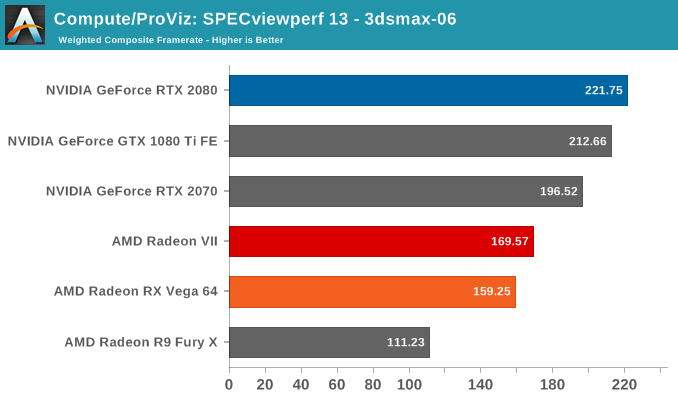
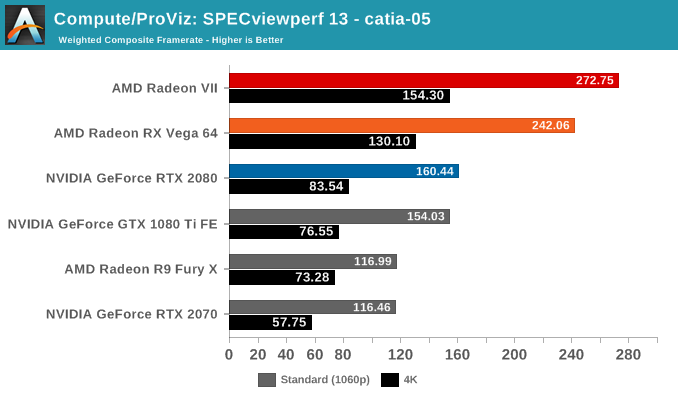

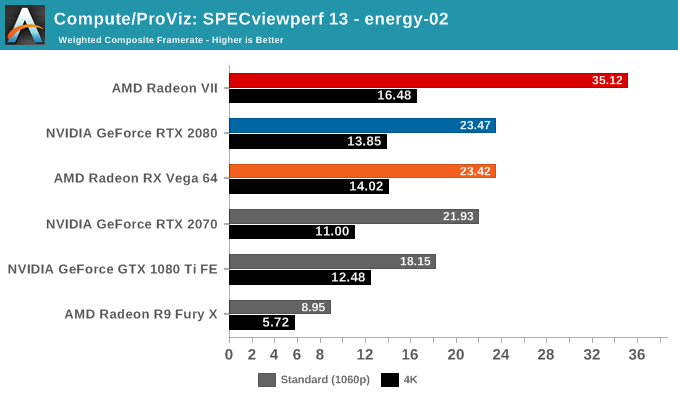
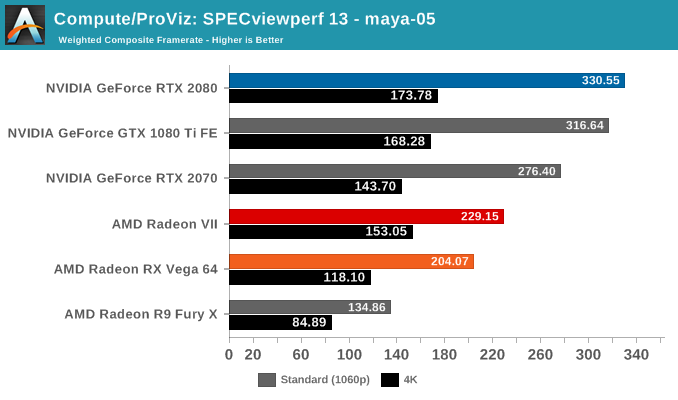
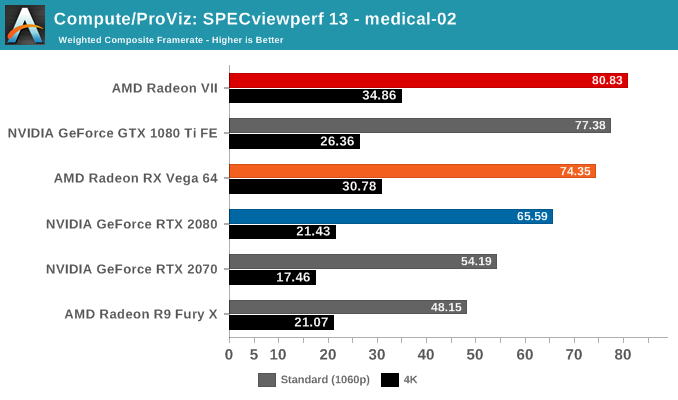
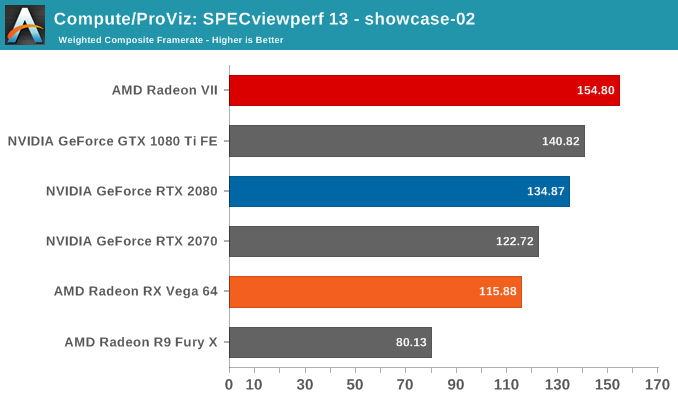
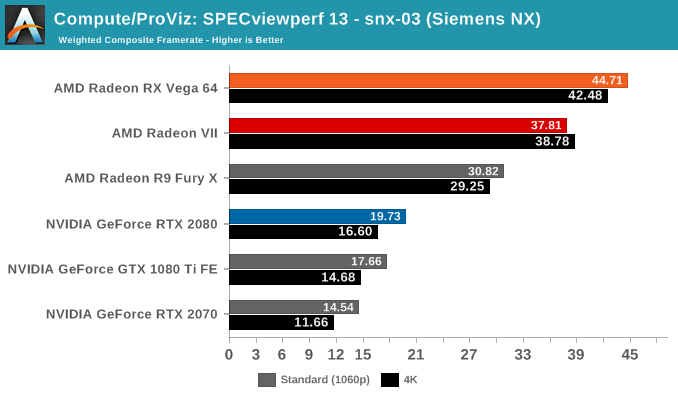
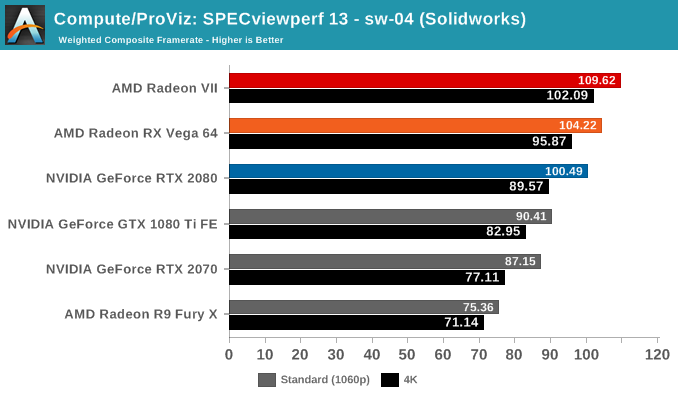
Looking over the results, it's clear that certain viewsets tend to perform better on one vendor's hardware than the other's. In those cases, the Radeon VII doesn't buck the trend, though in Siemens NX the lower performance is more likely than not related to driver maturity. In the reverse scenarios like in creo-02 or maya-05, the Radeon VII is in a similar spot, naturally ahead of the RX Vega 64 but behind the competing RTX and GTX cards. If anything, the results highlight the importance of software maturity for newer hardware, but there are definite signs of Vega 20 being a powerful workstation card. The caveat is that it doesn't seem to change the overall landscape for worksets that traditionally perform well on NVIDIA hardware.
Our next set of benchmarks look at rendering performance. To be clear, given the nature of ‘render wars’ as well as the adoption of CUDA, the featured render engines are not necessarily indicative of the overall GPU renderer landscape. Because we are looking at the Radeon VII, it’s not applicable to include some of the more popular renderers, such as Redshift and Octane, which are CUDA-only, and similarly the presence of Indigo Renderer helps as another datapoint even though it is less popular.


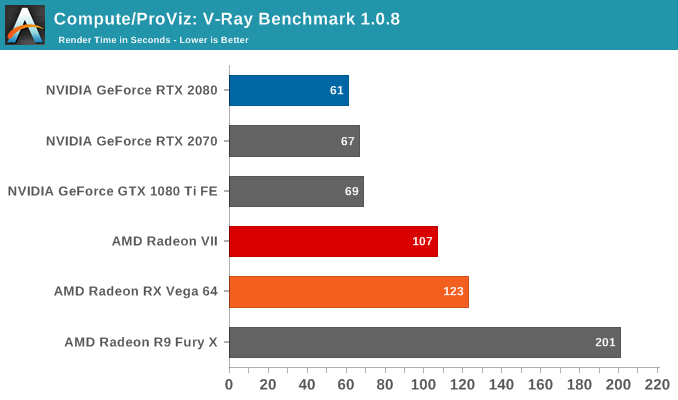

To note, official Blender releases have yet to incorporate CUDA 10, and so RTX 20 series cards are not officially supported.
V-RAY here is the only test that utilizes CUDA for NVIDIA cards, while the rest all use OpenCL. The results seem broadly similar to SPECviewperf, where the Radeon VII continues to excel at workloads where AMD hardware generally fare well.










289 Comments
View All Comments
HollyDOL - Sunday, February 10, 2019 - link
Please, read what others write before you start accusing others.eva02langley - Friday, February 8, 2019 - link
Yeah, when your speaker sound is at 70-80 dB next to you when playing CoD... /sarcasmAMD is going to solve the fan problems. Temps are lower than the RTX 2080, they can play with the fan profile a little bit better.
SeaTurtleNinja - Thursday, February 7, 2019 - link
Lisa Su is liar and AMD hates gamers. This is just a publicity stunt and a way to give a gift to their friends in the Tech Media. This was created for YouTube content creators and not for people who play games. Another Vega dumpster fire.GreenReaper - Thursday, February 7, 2019 - link
But many YouTubers play games as their content. And people vicariously watch them, so effectively it's letting many people play at once, just for the cost of the video decode - which is far more efficient!Korguz - Thursday, February 7, 2019 - link
yea.. amd hates gamers.. you DO know AMD makes the cpu and vid cards that are in the current playstation and xbox... right ???Oxford Guy - Thursday, February 7, 2019 - link
Yes, it's difficult to forgot the fiasco that is the Jaguar-based "console"(actually a poor-quality x86 PC with a superfluous anti-consumer walled software garden).
Korguz - Friday, February 8, 2019 - link
how is it a fiasco ??the original xbox used a Pentium 3 and Geforce for its cpu and gpu... the 360, and IBM CPU and ATI GPU...
Oxford Guy - Friday, February 8, 2019 - link
1) Because it has worse performance than even Piledriver.2) Because the two Jaguar-based pseudo-consoles splinter the PC gaming market unnecessarily.
Overpriced and damaging to the PC gaming platform. But consumers have a long history of being fooled by price tags into paying too much for too little.
eddman - Friday, February 8, 2019 - link
Consoles have nothing to do with PC. They've existed for decades and PC gaming is still alive and even thriving.Why do you even care what processor is in consoles?
Oxford Guy - Friday, February 8, 2019 - link
False. The only difference between the MS and Sony "consoles" and the "PC gaming" platform is the existence of artificial software barriers.